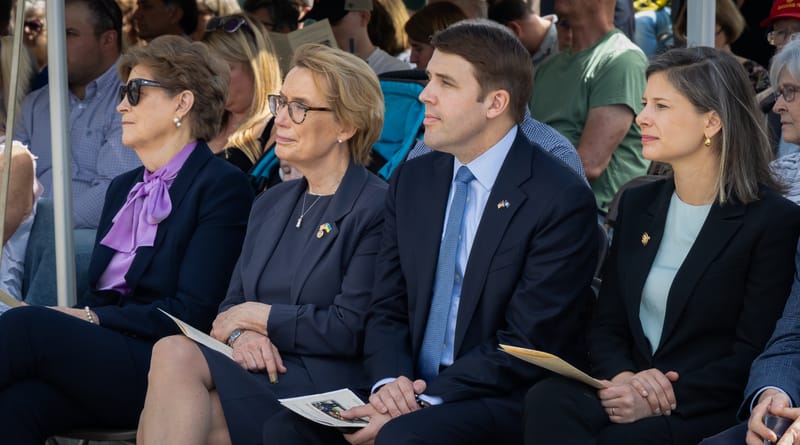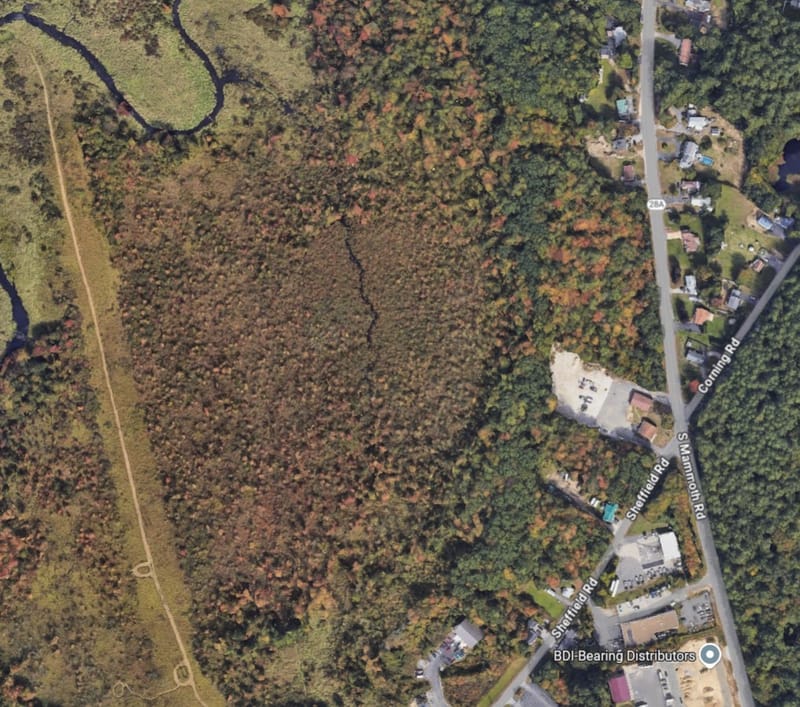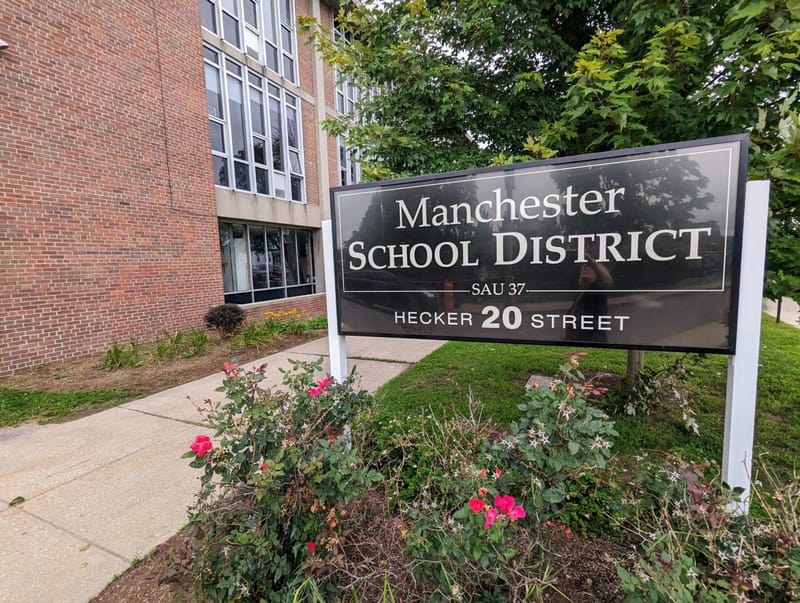Concord woman heard five ‘very loud’ shots minutes after seeing Reids on trail
The shots seemed to come from in front and to the right of where she was with her dogs. They were in quick succession, two and then three more, and very loud, she testified Friday in Merrimack County Superior Court as testimony continued in the second-degree murder trial of Logan Clegg. Clegg, 27, i
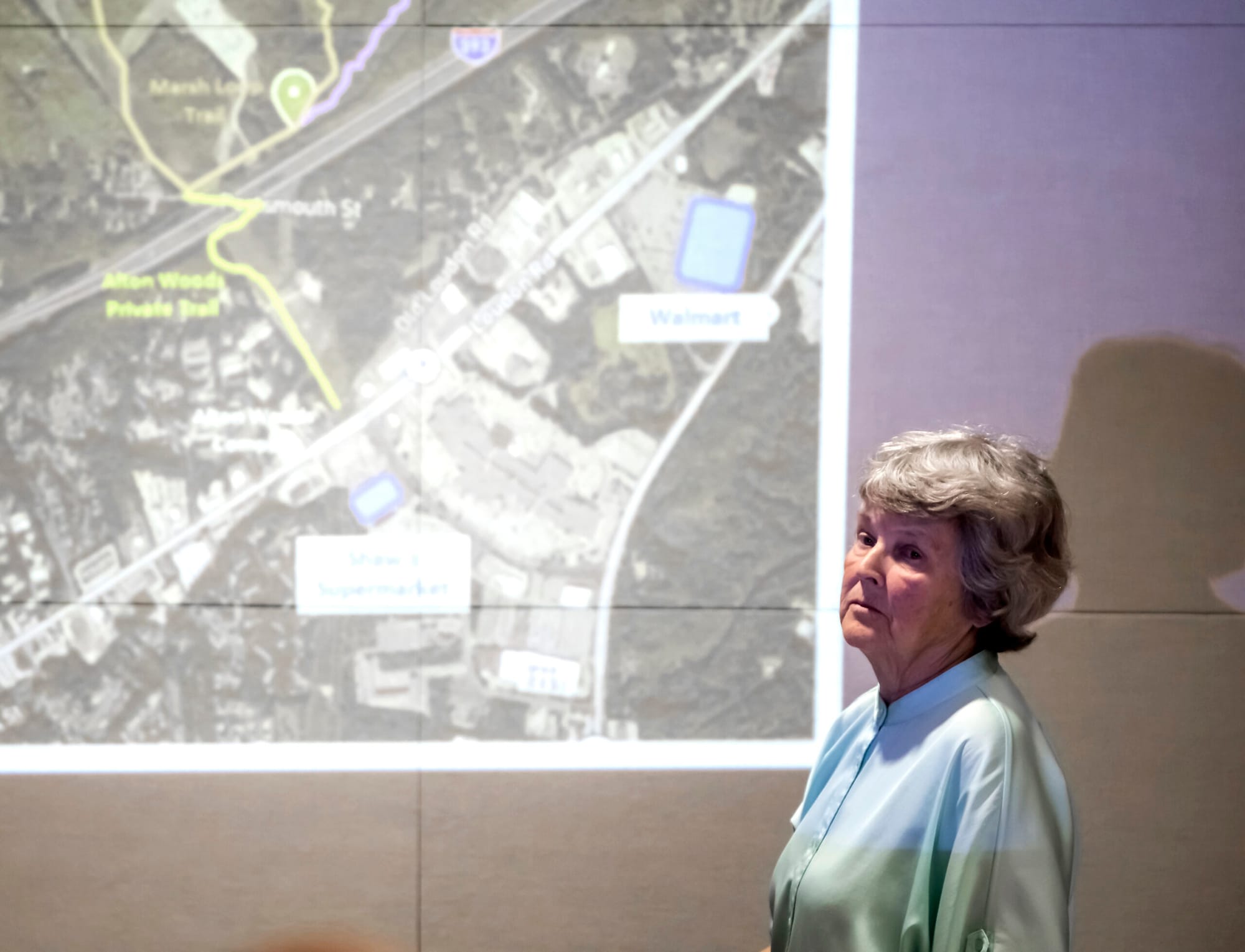

Story Updated 10 p.m.
CONCORD, NH – There weren’t many people on the trails at the Broken Ground Trail System early in the week of April 18, 2022, but three who did saw and heard things so unusual that they became indelible memories, and, as days passed, some of the puzzle pieces investigators used to charge Logan Clegg with second-degree murder.
Gunshots, a pile of burned propane tanks, shell casings along the trail, a young man who looked like he didn’t belong – they stood out to three people who were on the trails in northeast Concord on April 18 and 20, 2022. The three Concord residents testified Friday in Merrimack County Superior Court, where Clegg is being tried for second-degree murder, charged with shooting the Reids on April 18, 2022.
Also testifying Friday was Deputy Chief Medical Examiner Mitchell Weinberg, who said both Djeswende, 66, and Stephen, 67, suffered multiple gunshot wounds that immediately incapacitated them and quickly killed them.
The day investigators believe the Reids were shot, Nan Nutt had just entered the Marsh Loop Trail woods with her two small dogs when she heard five gunshots.
“Bang bang.” A two-second pause. Then, “bang bang bang.”
The shots seemed to come from in front and to the right of where she was with her dogs Cori and Bodi. The shots were in quick succession, two, the pause, and then three. They were very loud.
“I jumped, and the dogs jumped,” Nutt said during Friday’s testimony.
About five minutes before Nutt heard the shots, the Reids passed her and her dogs on the trail along the power lines that led to the trail. Because the dogs, an 18-pound poodle mix and a 24-pound mix of undetermined breeds, were slow and liked to explore and sniff, Nutt stepped aside to let the Reids pass.
The couple were chatting comfortably, and Stephen Reid nodded to Nutt as they walked by. The couple then disappeared from view. Nutt saw the one last time, about 200 yards ahead of her on the power lines trail, as they went into the woods.
Nutt, who’s “not a gun person,” said the shots sounded more like a handgun than a rifle. Under cross-examination by defense attorney Mariana Dominguez, she said she used to have a neighbor who had a shooting range, and she was familiar with the sound.
During direct examination, Assistant Attorney General Joshua Speicher asked her what her first thoughts were when she heard the shots.
She said her first thought was that she wasn’t wearing hunter orange. Then she realized it was April, not hunting season. “My second thought was that I’ve been watching too much awful TV,” Nutt, a retired researcher with a Ph.D. in immunology, said. “After I thought I’d been watching too much bad TV, I thought it was time to walk on. And I did.”
Minutes after that, Nutt saw a man up ahead on the trail, standing still and looking into the woods to Nutt’s right. “My first thought was that he heard the same shots I did,” she said.
But as she got closer, she became uneasy. He was slender, white, about five-foot-10, dressed in khaki pants, a navy blue sweatshirt and carrying a backpack. He didn’t look like someone hiking the trails, but more like a street person, or homeless person.
“He appeared to be staring at, not scanning,” the woods, Nutt said. When she was five to 10 yards from him, he turned and looked at her.
Speicher asked her how the man looking at her made her feel.
“He made me feel anxious,” she said. “I think I determined he already didn’t belong on the trail, so that combination affected me.”
Nutt brought her dogs in short and passed him without looking him in the eye.
When Speicher asked her why she didn’t look at him, Nutt responded, “Like most women my age, if it’s a male you don’t know, you don’t look them in the face [when you pass them], and he already made me anxious.”
After they passed, she turned around briefly to see if he was walking away. He was, but he’d also turned to look back at her. They broke eye contact. Moments later, she turned once more, quickly, to make sure he was still walking.
Speicher asked her why she looked back.
“He’s already made me uncomfortable, and I thought ‘I’m going to turn around and remember what this guy looks like’,” she said.
Police investigators and the prosecution believe the young man was Clegg.
The Reids’ bodies were found April 21, 2022, down an incline from where Nutt and the man are thought by investigators to have crossed paths. The couple had apparently been dragged there and had been covered with leaves and sticks.
Nutt’s walk, including her pace, where she went and the times she started and stopped were recorded on her Apple watch. Speicher projected on the wall a screenshot from the phone app that tracked her watch, showing when she circled Marsh Loop, beginning at 2:48 p.m. when she walked out of the parking lot below the trail and ending 51 minutes later when she got back in her car.
A couple of days after Nutt heard the shots on the trail, a friend showed her a news article about the Reids, who had been reported missing.
Nutt called the police. She was initially interviewed by one officer, and later contacted by Det. Wade Brown, who had her write out a statement. She submitted it to police on April 23.
Nutt in court Friday described the man as carrying a brown or beige plastic grocery bag that looked heavy, and she saw the top of cylinder-shaped object, similar to a peanut butter jar, pressed against the inside of the bag. She did not see what the object was.
Clegg had shopped at the Shaw’s supermarket shortly before the Reids were shot, and was captured on surveillance video walking across the grocery store parking lot toward Loudon Road. The Broken Ground Trail System is through a neighborhood, across Loudon Road, in that direction.
Receipts show that Clegg bought a cooked rotisserie chicken and a large bottle of Mountain Dew at Shaw’s.
Nutt testified the only other person she saw on her 51-minute walk, recorded with her Apple watch, was a man at the intersection of Marsh Loop and Nowell trails, a while after her encounter with first man.
She stopped and chatted for about a minute with the man, who she said was in his 60s and dressed like a hiker. She testified that he did not make her feel uncomfortable. “I felt like he was a kind person,” she said.
Dominguez, on cross-examination, zeroed in on the khaki pants that the first man Nutt saw was wearing.
Nutt had told Speicher she could not say what shade they were, and Domiguez said, “But they were tan and brown, not blue, not black?”
Nutt said that was true. Clegg, in surveillance footage appeared to be wearing dark, possibly black, pants that day.
She asked Nutt if she’d had a clear view of his face, and Nutt said she only saw his profile.
Also, in answer to Domiguez’ questions, she said that he didn’t have any blood or scratches, and was not sweating.

The missing bullet casings
The second man Nutt saw that day may have been Allan Schwarz, who hiked several trails around the perimeter of Broken Ground Trail System on April 18, 2022. He believes he heard four gunshots at around noon.
“Bang. Bang.” Pause. “Bang. Bang,” he said when Assistant Attorney General Ryan Olberding asked him to describe the shots. About an hour and a half later, near the end of his walk, Schwarz spotted bullet casings along the Marsh Loop trail, two on either side of the trail.
He picked one up to see if he could see markings or a caliber. He didn’t, and so he dropped the casing approximately where he’d found it. He looked around to see if he could figure out what someone had been shooting at but didn’t see a likely target.
Olberding asked him why he was interested in the casings.
“They were out of place,” Schwarz, who frequently walks on the trails, said. “They were very noticeable to me. I just wondered what was going on.”
After he learned the Reids’ bodies were found, he went the next day, April 22 to the trail system, where he told police what he’d heard and found. A detective accompanied him to where he had seen the casings, but they couldn’t find them.
In cross-examination, defense attorney Caroline Smith pressed Schwarz on the search for the casings with police, both April 22, and about a week later with two other detectives, who walked his entire route with him. She asked if the first detective who went with him April 22 had a metal detector, but Shwarz couldn’t remember.
When he went back with police, he also couldn’t remember the exact location on the trail where he saw them, but thought a specific tree was a landmark.
“I was doing a lot of things trying to figure it out,” he said in response to Smith’s questioning. “I didn’t realize the significance of what I had seen on Monday [when he first saw it].”
Schwarz also couldn’t remember telling police on his second visit with them to the site that a beaten-down path that led to where the bodies were recovered had been there before.
On his walk, he remembered passing a woman walking one dog, and no one else. He couldn’t remember what kind of dog it was, but was sure that it was only one.
He told Smith he was sure he heard four shots, even though he initially told police he heard four or five. In response to her questioning, he said he was sure he saw the casings, and sure he left them where they were.
In April 2023, he called Det. Wade Brown to find out if was all right to talk to the defense team. During that conversation, Brown asked Schwarz twice if he might have picked up the casings, taken them home, then brought them back to the scene sometime after it was initially searched.
Smith asked him about that conversation.
“When I left [April 18, 2022], there were four casings on the ground,” he said. “I never touched them, never moved them.”
He also acknowledged that he never responded to the defense team’s request to talk.
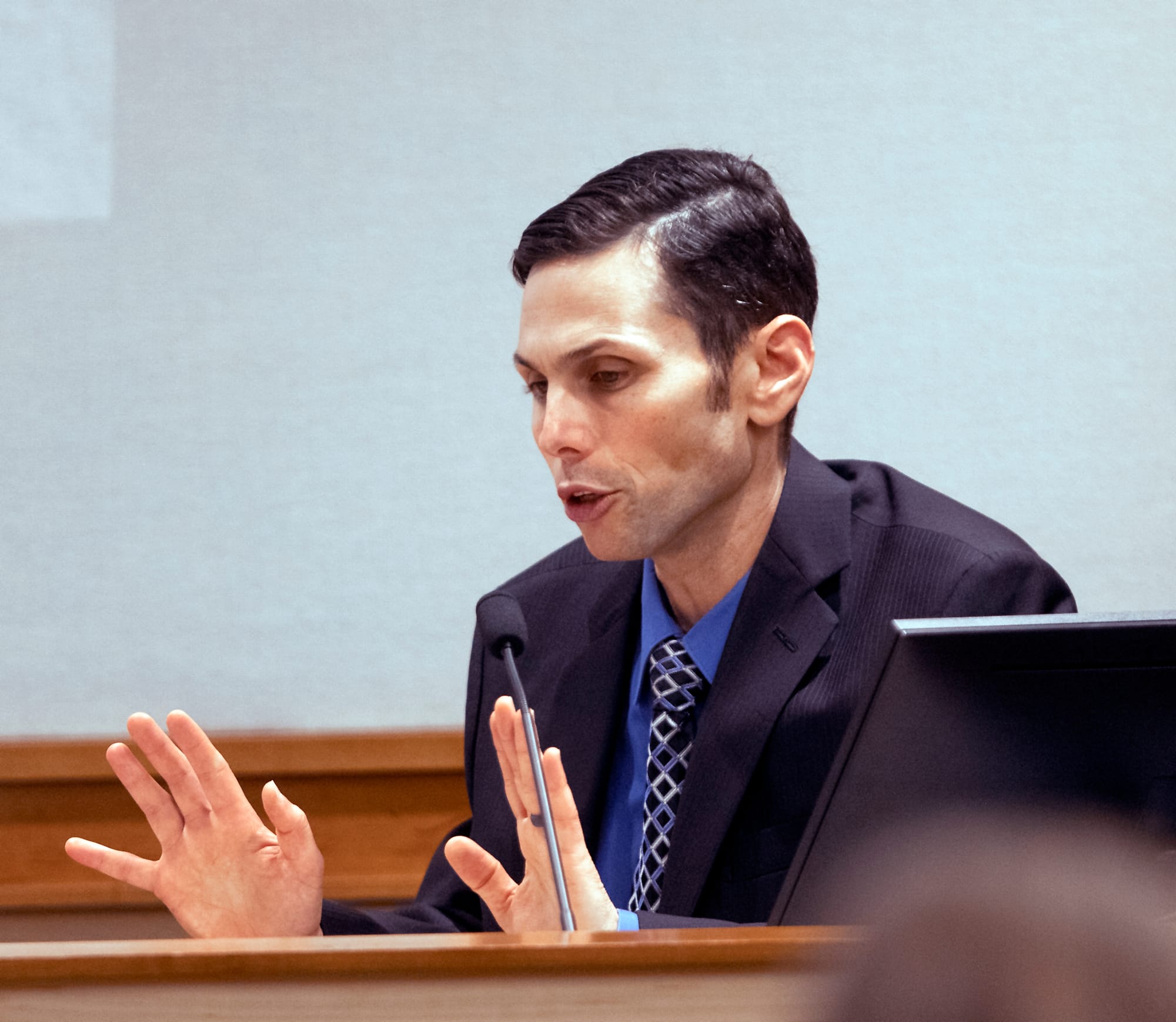
A pile of burned propane tanks
Also testifying Friday morning was Eliseo Medina, who lived nearby and frequently biked and hiked in the woods.
Medina was taking a bike ride up the power lines trail on Wednesday, April 20, 2022, when he saw a pile of burned camping-size propane tanks in the woods near the Profile Avenue Connector. Medina thought the pile of burned containers looked out of place, so he took several photographs of them. He also took a photo of a large rock under the power lines, to mark a spot near the woods where the tanks were.
When he found out about the Reids, Medina called Concord police, told them what he’d seen, and gave them the photos.
That spot came to be known as the “burnt tent site” by police investigating the Reids’ death. The pile of propane tanks and bullet casings found underneath four months later, in August, were the topic of much of Thursday’s testimony.
Weinberg, who performed forensic autopsies on the Reids April 22, 2022, was the final witness to testify on Friday, detailing the gunshot wounds that killed the Reids.
Djeswende Reid was shot twice, both near her right ear. One shot went through her neck and exited the other side. The other embedded in her brain caused acute damage and likely killed her quickly, Weinberg said.
Stephen Reid was likely shot four times, with some of the bullets leaving, then reentering his body. His wounds were to the left shoulder, left neck, upper back, hand and chest.
Weinberg said he couldn’t know for sure how many shots were fired, but it was between five and seven, with his best guess six.
He said that lack of soot and “stippling” on the Reids (marks caused by gunpowder) meant the shots came from three feet or more away, but he couldn’t say how far.
To both Olberding and Smith, he said, “I can’t differentiate if it was four feet away or 14 feet away.”
He elaborated under cross-examination that the distance was the end of the muzzle of the gun to the skin of the victim, and couldn’t say how the gun was being held that would determine how far away the shooter was.
Weinberg said abrasions on the Reids’ torsos happened after they died, and “were consistent” with being dragged, though he said he couldn’t know for sure what caused them.
Smith spent a lot of time asking Weinberg about lividity – the coloring of the skin where blood pools when a body has been lying in one position for a while after death – with the end result that Weinberg didn’t believe the bodies had been moved after they’d been dead for several hours.
The most intact bullet was taken from Djeswende Reid. All of the shots to Stephen Reid had also exited and there were only tiny fragments to be found. Weinberg said, in response to Smith’s questions, that he could not determine caliber or type of bullet.
“That’s why you recover a projectile and send it to ballistics for analysis,” he said.
Smith also quizzed him on possible angles of both the Reids and guns, but Weinberg was hesitant to speculate.
“Shootings are not static,” he said. “Victims move,” particularly when there are multiple gunshots, because they’re trying to get away, their body is reacting to being shot, or other reasons. He said it’s not unusual for shots to look like they’ve come from different directions.
At the end of Weinberg’s testimony, Smith asked if, when he was taken back to the scene a month later with other investigators, he heard “an exclamation” from one of the investigation team members from behind a tree on Marsh Loop Trail.
He said he didn’t remember exactly what happened, but there did seem to be “a reaction” to something. He didn’t stick around to find out what was going on. “I’d seen what I was there to see and left soon after,” he said.
The question was likely to help the defense establish questioning of the credibility of shell casings found on Marsh Loop Trail weeks after the Reids’ bodies were recovered. Testimony on that finding has yet to be introduced by the prosecution team.
Starting off Friday’s testimony, Concord Police Department Det. Nicole Murray briefly took the stand to continue her testimony about evidence collected at the tent site, as well as the scene where the Reids’ bodies were found, and another tent site that police say Clegg lived at in Vermont.
In redirect, Assistant Attorney General Ryan Olberding had Murray clarify the process for moving bodies – the medical examiner does it, gloved, and seals the bodies in body bags until they an be examined.
He also asked about the difference between an indoor and outdoor crime scene.
“An indoor scene is very contained, it’s not open to the public,” Murray said. “An outdoor scene is very vast” and investigators “have eyes on thousands of things,” and it’s open to the elements.
On cross-examination, defense attorney Mariana Dominguez asked Murray how many items were sent to a Florida lab to be tested for DNA. Murray didn’t know an exact number, but said, “pure guess, maybe 30 to 50.”
The trial began Tuesday with opening arguments and a site visit to the Broken Ground Trail System, with testimony beginning Wednesday in Merrimack County Superior Court, with Judge John Kissinger presiding. The trial resumes at 9 a.m. Tuesday, with Monday off for the holiday. It is expected to last until Oct. 20.
Clegg is charged with two counts of second-degree murder for “knowingly causing the death” of each of the Reids, two alternative second-degree murder charges for “recklessly causing” their deaths, three counts of falsifying physical evidence and one count of being a convicted felon in possession of a firearm and one count of falsifying physical evidence (a Class B felony) was added.
He’s been held in Merrimack County Jail since he was extradited to New Hampshire following his arrest on a Utah fugitive warrant in South Burlington, Vermont, Oct. 12, 2022.


